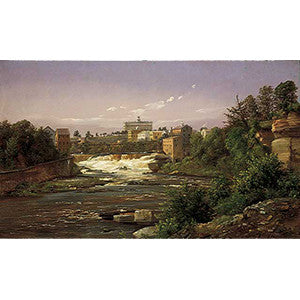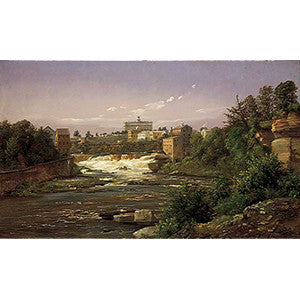St. Anthony Falls, 1857
St. Anthony Falls, 1857
Couldn't load pickup availability
St. Anthony Falls shows the east channel of the Mississippi River in 1857 and the booming little town of St. Anthony, Minnesota, built close to the falls, as well as the picturesque wildness of the river scenery below the town. On the left is Hennepin Island with its flour mills and the sluice that carried lumber from sawmills below the rapids for rafting to the lower river.
The Winslow House, a well-known early hotel, dominates the hill in the background, and in the right foreground stands a wood-products factory. The artist depicted the town at the high spot in its development, for St. Anthony never recovered from the financial panic that hit only a few months after the picture was painted. In 1872 St. Anthony was combined with Minneapolis, its prosperous rival across the river. Thereafter, the water power of the world-famous Falls of St. Anthony contributed to the development of Minneapolis and its two great early industries of sawmilling and flour milling.
Ferdinand Reichardt (1819-1895) was a Danish-born landscape artist who was especially noted for his paintings of Niagara Falls. The romance of the Mississippi, however, seems to have captured his imagination, presumably when he traveled through Minnesota in the 1850s. In his New York City studio Reichardt created several evocative scenes of life along the river, such as St. Anthony Falls and View on the Mississippi River (also known as Steamboats on the Mississippi), both painted in 1857 and in the MHS Collections. A rendition of fashionable sightseeing by steamboat on the river, executed in 1858, is in the collections of the White House. All are probably based on sketches and material gathered during Reichardt’s visit to the Mississippi Valley, and all are rich in fine detail.
Reproduction of oil painting in the collections of the Minnesota Historical Society. 31" x 21".
Share


